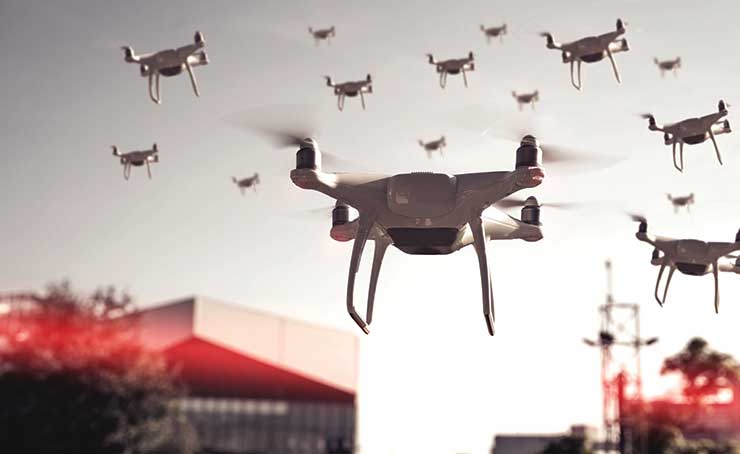
In recent global conflicts, revolutionary technologies such as swarms of drones, loiter munitions, AIML, and mixed reality have emerged, challenging conventional systems with their enhanced efficiency, agility, and security in combat tactics and training. India stands at a crucial juncture, poised for a transformative leap toward achieving defence autonomy. The convergence of factors, including a thriving domestic defence industry—especially the Indian start-up ecosystem—the expertise of Indian academia in cutting-edge research, and the substantial demand for technological solutions from the Indian defence, presents a unique opportunity for India to become completely “Atmanirbhar.”
Global Trends: Model of Triple Helix
Outlining the dynamic interplay among academia, industry, and government, The Triple Helix model was introduced in the US in 1995, emphasising its collaborative role in fostering entrepreneurship, innovation, and economic growth. In this model, each actor plays a distinct role: Government provides funding, industry contributes resources and expertise, and academia generates knowledge through research. Together, they form an interconnected network to generate ideas, test them in real-world scenarios, and refine them into commercially viable products or services. We see the testimony of the model in many countries like China’s “Made in China 2025” and the European Union’s “Horizon 2020,” which aim to move away from low-cost manufacturing towards high-tech industries like robotics or AI software development and focus on stimulating economic growth through investing in research projects.
In India, this collaborative effort has been demonstrated in some fields to address critical challenges and achieve significant outcomes, such as the collaboration between the Government (ICMR, MoH), Academic institutions (IISc, AIIMS), and Industry (Bharat Biotech, Serum Institute of India, Dr Reddy’s Labs) in the development and distribution of COVID-19 vaccines. This synergy has also been proven successful in multiple goal-oriented missions like Mangalyaan and Chandrayaan missions by ISRO.
Strengths & Opportunities in Defence
In the 2024 interim budget, ₹6,21,540.85 crore was allocated for the Ministry of Defence (MoD) with 70.6% for revenue and 29.32% for capital, reflecting a commitment to India’s economic aspirations to rank in the world’s top three. This year, through Emergency Procurement (EP) deals worth ₹23,500.00 crore are executed, highlighting ongoing efforts by the Government, such as establishing Defence corridors, launching Innovation for Defence Excellence (iDEX) programs, Public-Private Partnerships (PPP), Production Linked Incentive (PLI) scheme, MAKE (I,II,III), Defence India Start-up challenges (DISC), Centres of Excellence (CoE), targeted funds, and revised financial powers. Multiple MoUs are getting inked between MoD/armed forces with defence public sector undertakings (DPSUs)/academia/private players. UP defence corridor alone has signed more than 138 such MoUs recently.
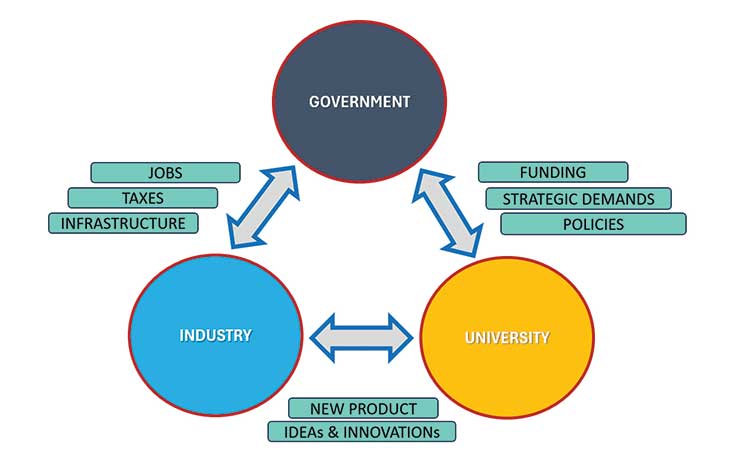
These current initiatives largely focus on requirements within specified domains, whereas many grassroots opportunities in the armed forces can be explored. Achieving complete defence autonomy requires synergy among these efforts through a centralised and comprehensive framework of collaboration among industry, academia, and the armed forces. This article aims to study broader strategies to enhance collective synergy and bridge the demand-supply gap effectively.
Exploring The Synergy
The Indian defence ecosystem can draw insights from the triple helix model, where armed forces, academia, and industry can join hands in a collaborative framework, implementing key elements such as fostering interdependence, adapting strategies, promoting cross-sector collaborations, establishing feedback loops, aligning government policies with private sector actions, encouraging public-private partnerships, facilitating open access to information, conducting technology transfer activities, protecting intellectual property rights, offering incentives for innovation, building capacity among stakeholders, and providing education and training programs for modern innovation systems.
It is essential to develop policy formulation and regulatory frameworks in accordance with government guidelines to synchronise and operationalise this synergy, which should act as a facilitator in handling defence concerns through academic innovation and industry resources. An initial exploration of bilateral equations is necessary to achieve synergy among the armed forces, academia, and industry.
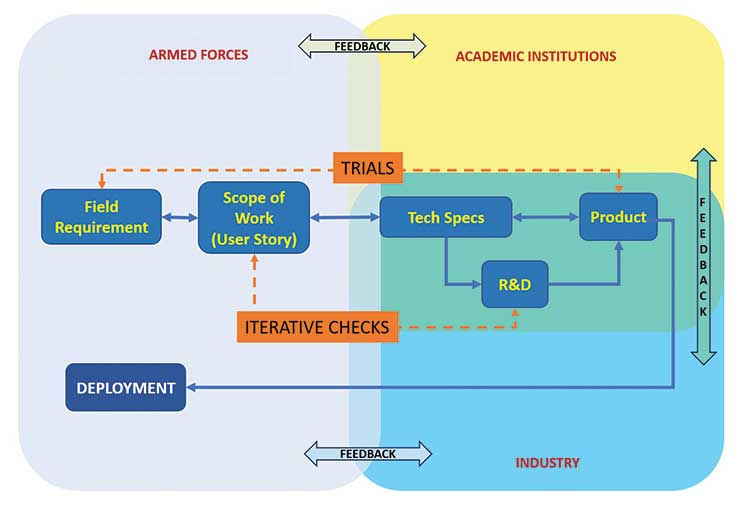
Academia & Armed Forces
Indian academic institutions, including but not limited to IITs, IISc, and IIMs, possess knowledge, resources, and state-of-the-art research facilities. They currently collaborate with the armed forces through Quality Improvement Programs (QIPs) and project engagements via MoUs. In the proposed synergy, fostering active involvement between academia and the armed forces is crucial. Existing schemes require restructuring to facilitate a stronger connection between them. Research conducted should align with current defence needs, necessitating centralised infrastructure for knowledge repositories.
Priority to Defence Start-up Incubation programs aimed at addressing specific defence solutions is a must. Such collaborations necessitate dedicated funding and access to armed forces datasets, encouraging partnerships between local military authorities and academic institutions to enhance resource accessibility. Students should be given exposure to the armed forces through internships and vice versa. Additionally, academia should design programs tailored to directly support the armed forces, as demonstrated by initiatives like the 3-month drone training program hosted by IIT Guwahati exclusively for defence personnel.
Academic institutions within the armed forces like military colleges (MCEME, MCTE, CME) having the capitalisation of knowledge can build strong ties with industry. The students and faculty, being part of the armed forces, have an advantage in mapping military requirements with multi-discipline technology solutions.
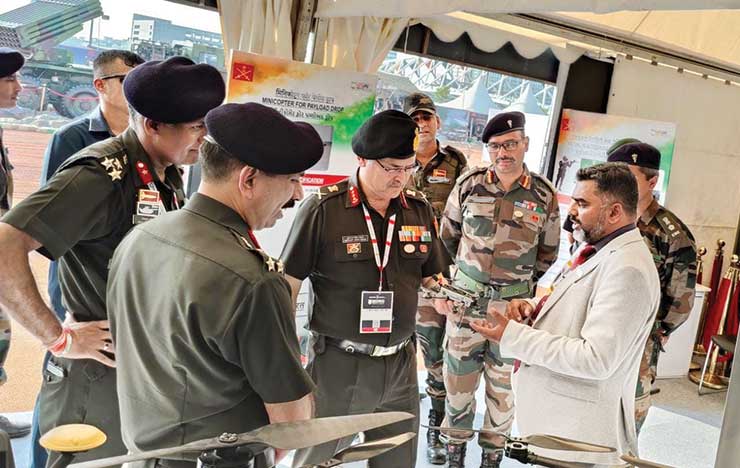
Industry & Armed Forces
The Indian industry (public and private sectors) excels in manufacturing electronics and software development. Initiatives like industry-sponsored research projects, internships, and joint ventures promote essential skill development. Until recently, there has been a 200% increase in defence licensing for MSME start-ups. Collaboration between the industry and armed forces requires a framework for resource exchange, including methods for technology transfer, inter-domain long-duration transfer between academia and industry (including private players), and the establishment of hybrid facilities for production.
Given the modern warfare landscape’s reliance on digitisation and rapid data processing, this synergy can prioritise access to indigenous processors and semiconductor development to ensure readiness for future challenges.
Academia & Industry
The industry should leverage the knowledge and research acumen of academia to develop defence inventory through interaction engaging both industry managers and university faculty. Strengthening knowledge transfer can occur through internships, informal communication, conferences, publications, and cooperative programs. Defence start-ups emerging from academia should collaborate with established industry partners.
In the proposed synergy, fostering active involve-ment between academia and the armed forces is crucial. Existing schemes require restruc-turing to facilitate a stronger connection between them
In addition to the defence PSUs, product development and proliferation within the armed forces are customised to operational needs and supervised by organisations like the Army Design Bureau (ADB), Simulator Development Division (SDD), and Army Based Workshops (ABWs), along with similar ones in the air force and navy like Weapons and Electronic Systems Engineering Establishment (WESEE) and Software Development Institute (SDI). These entities collaborate closely with the industry and academia to meet the requirements on the ground through innovation.
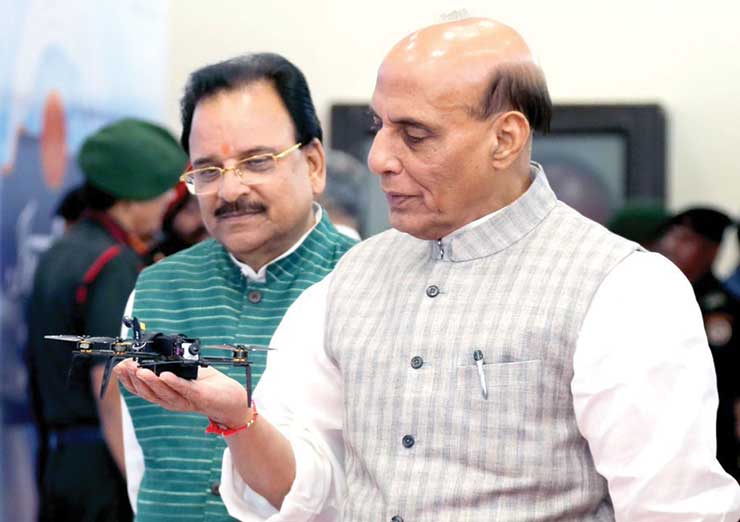
Advanced simulators and drone systems developed internally by SDD of the Indian Army are appreciated by the Indian top leadership. The base workshops have been directly tackling production and MRO challenges, which require a thorough reassessment to realise their significant potential as key players within this synergised framework, effectively functioning as both an industry entity and an integral part of the armed forces. Continued momentum to such institutes, interdepartmental synergy, and internal dissemination within the armed forces are essential.
Way Ahead
In a centralised framework, the focus is on exploring the essence of synergy and the anticipated contributions from academia, industry, and the armed forces to establish a closed-loop ecosystem where ideas circulate seamlessly between sectors. This requires a comprehensive roadmap integrating goal-oriented R&D programs to promote innovation and indigenous manufacturing with key aspects of managing niche technologies, mapping user stories, defining product scope and pricing, and bringing together stakeholders from diverse sectors.
The goal is to reduce reliance on imports leveraging India’s advanced research capabilities. Establishing a comprehensive database of indigenous research and enabling stakeholders to connect research findings with practical applications can achieve self-reliance. Additionally, creating technology transfer centres at academic institutions and a clear determination of intellectual property rights facilitate the transition of research into commercial goods, fostering this collaboration.
In a central-ised frame-work, the focus is on exploring the essence of synergy and the antici-pated contribu-tions from academia, industry, and the armed forces to establish a closed-loop ecosystem where ideas circulate seam-lessly between sectors
Supporting synergy requires capital, a challenge for the start-up industry. Customised engagement schedules can offer initial financial support for proof of concepts (POCs) and demos, enabling practical field trials instead of non-committal demonstrations. Defence authorities overseeing projects should exercise financial independence under Delegation of Financial Powers for Defence Services (DFPDS) schedules to further streamline research and development coordination.
The armed forces may contemplate outsourcing high-tech roles to veterans, along with retired Agniveers, who can contribute as subject matter experts in training and maintenance tasks, benefiting both the armed forces and the industry. Simplifying processes, decentralising decision-making based on technological complexity, and streamlining procedures are key to effectively scaling up innovative ideas. Despite the annual generation of numerous ideas and innovations within the armed forces, only a few successfully scale and persist over time. The synergised framework should ensure that every genuine idea progresses to the patent stage and fulfils its intended purpose. Establishing combined sandboxes for testing and execution is crucial, as it allows for thorough exploration of high-tech systems, gathering essential data, and implementing standardisation measures to maximise their potential.
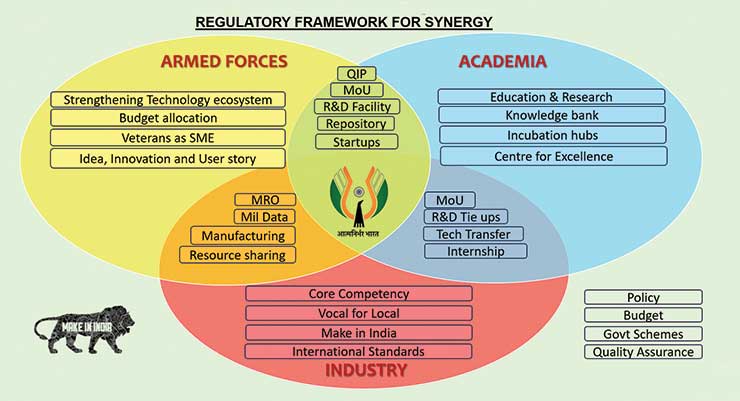
Conclusion
India’s journey towards defence self-reliance and global leadership relies on the synergy among the armed forces, industry, and academia. This collaboration drives innovation to address the demands of digitised warfare, enhancing autonomy in defence manufacturing. While recent budget allocations and initiatives reflect government commitment, there’s room for further exploration. Expectations encompass strengthened R&D, industry initiatives, and advancements in key technologies like semiconductors, drones, blockchain, and big data analytics.
Ultimately, embracing synergy with evolution and adaptation will position India as a leader in defence innovation, enhancing national security, and contributing to global peacekeeping through interdisciplinary collaboration. Genuine self-reliance will be achieved through leveraging local talent, local innovation, and local technology within a centralised foundational framework.
–The writer is an SME and independent consultant in military technology.The views expressed are of the writer and do not necessarily reflect the views of Raksha Anirveda















